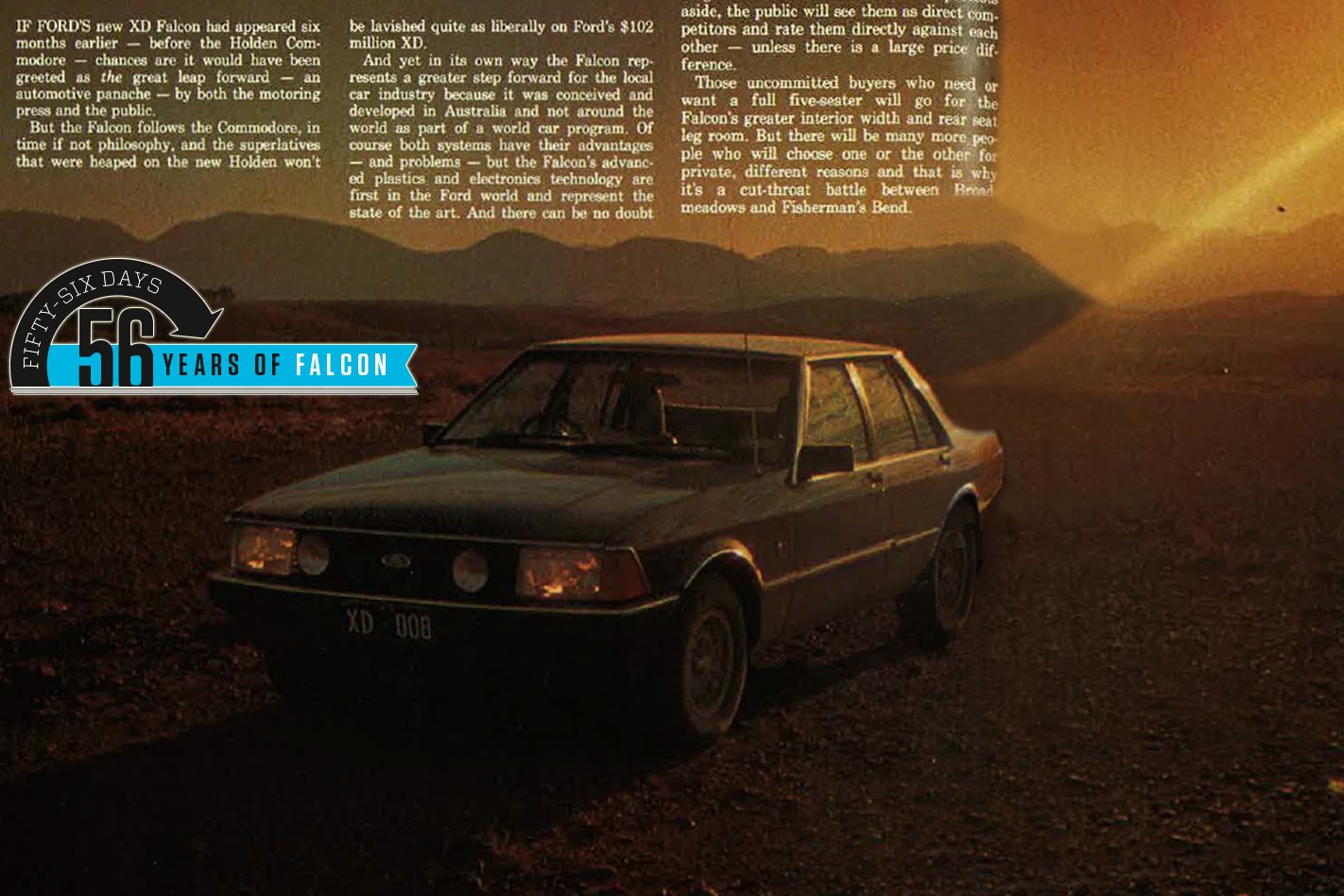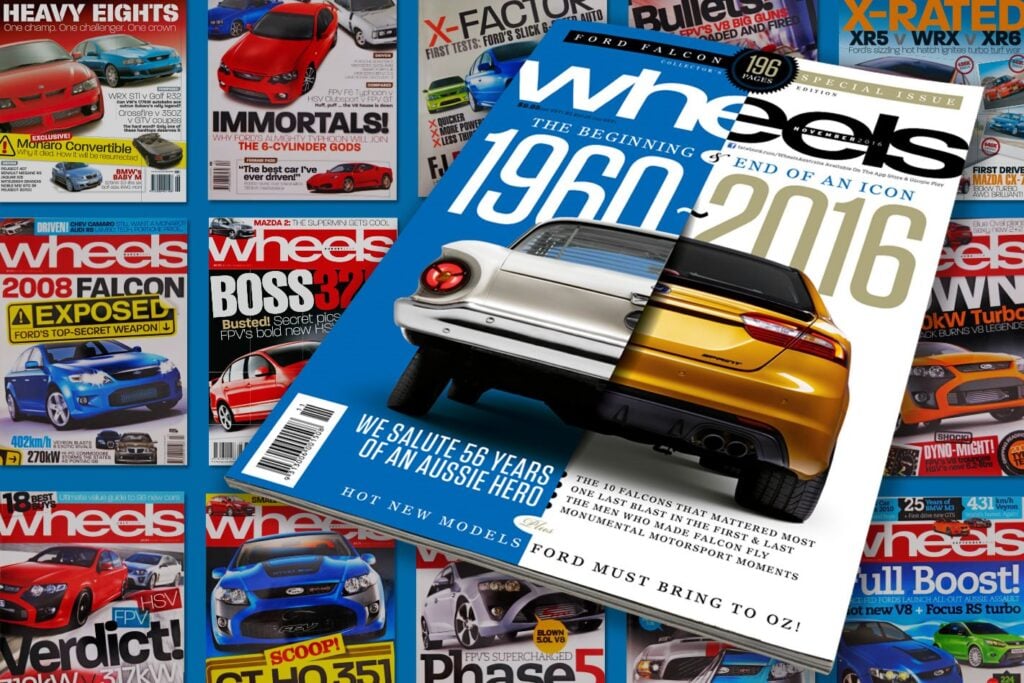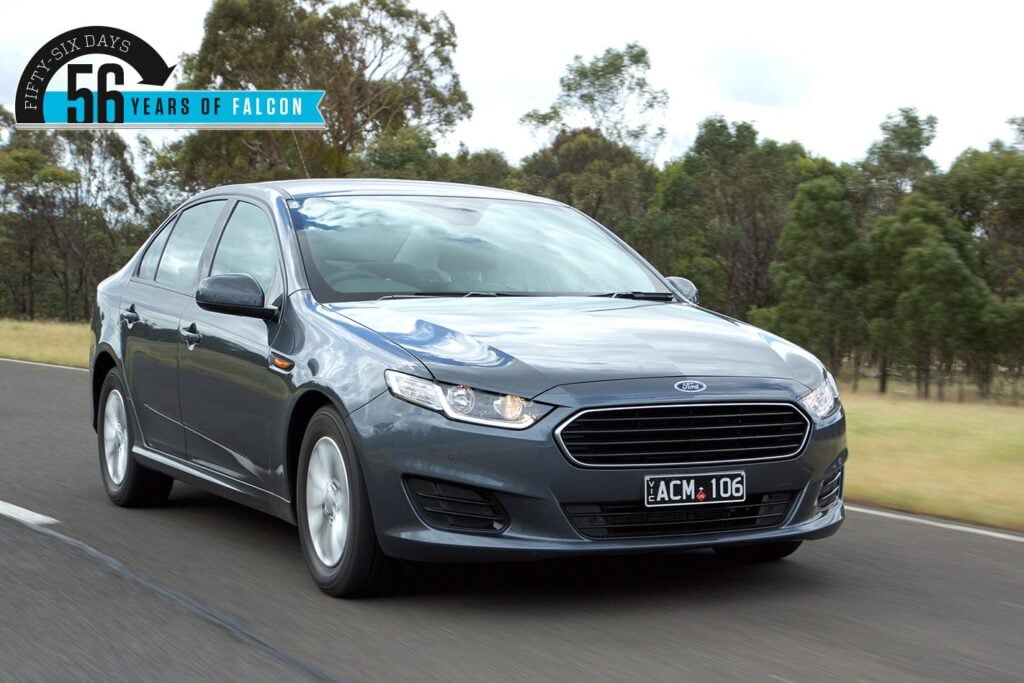First published in the January 1979 issue of Wheels magazine, Australia’s best car mag since 1953.
We finally get our Aussie designed and developed Ford Falcon.
IF FORD’S new XD Falcon had appeared six months earlier – before the Holden Commodore – chances are it would have been greeted as the great leap forward – an automotive panache – by both the motoring press and the public. But the Falcon follows the Commodore, in time if not philosophy, and the superlatives that were heaped on the new Holden won’t be lavished quite as liberally on Ford’s $102 million XD. And yet in its own way the Falcon represents a greater step forward for the local car industry because it was conceived and developed in Australia and not around the world as part of a world car program. Of course both systems have their advantage – and problems – but the Falcon’s advanced plastics and electronics technology are first in the Ford world and represent the state of the art. And there can be no doubt that the new smaller, lighter Falcon with its increased room, improved fuel economy and better performance is a giant step ahead or the old Ford Falcon XC. It is as if all the criticisms of a now ageing car have been wiped away while all its virtues have been retained. It is hard, indeed impossible, not to compare the XD with the Commodore, despite Ford’s assertion that the Falcon is in a different class because it retains the XC’s wheelbase of 2818 mm – that’s 150 mm longer than the Commodore. Ford’s protests aside, the public will see them as direct competitors and rate them directly against each other – unless there is a large price difference. Those uncommitted buyers who need or want a full five-seater will go for Falcon’s greater interior width and rear leg room. But there will be many more people who will choose one or the other for private, different reasons and that is why it’s a cut-throat battle between Broadmeadows and Fisherman’s Bend.
• lt retains a long wheelbase but is only a couple of centimetres longer than the Commodore
• lt’s big inside but small enough outside to change big car thinking
• Its 3.3-litre six performs as well as the old 4.1
• lt’s lighter and more efficient
• But it’s not a car that makes you forget it’s a Ford
The Falcon’s beginnings are very different to those of the Commodore. Ford began researching its replacement ot he XA-XC Falcon in late 1973. The choices were many.
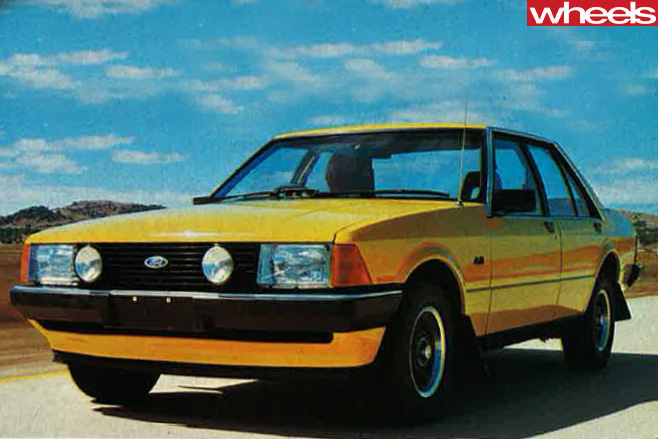
It made sense then – and it still makes sense after driving the XD in 1979.
The new Falcon still feels like a Ford. You don’t, as was necessary with the Commodore, have to look for a badge to confirm its identity. The XD is a Ford Falcon and many will be the customers who’ll appreciate that. Ford believes strongly in the healthy future of what it calls the E-car class – Falcon/Holden Kingswood/Valiant – and it sees the Commodore as a D-class car – Granada-like – and as being closer to the Cortina in size. In Ford talk the Cortina is in C/D-class, the Escort being a C-class car. But the divisions between classes are not precise and it is the extra width which really gives the XD its advantage over the Holden Commodore.
Width was required for the Fairlane/LTD models which will be built on the same, longer 2946 mm wheelbase as the Falcon station wagon. Because the Commodore is relatively narrow it’s hard to imagine GMH stretching it in wheelbase and length to create a new Statesman. Hence the General’s need to reskin the HZ.
Ford’s research shows that 35 percent of Falcons are in rural areas, that 53 percent are owned by fleet or governments and that 53 percent have tow bars. All good reasons for retaining a medium-sized five or even six-seater sedan – yes, bench seats and three-on-the-tree column gearshift live on in the XD.
But the new Falcon isn’t the slightly claustrophobic, obviously big, car of old. It is space-efficient, has improved manoeuvrability and with 20 percent more glass area has far superior all-round visibility. In fact the driver can see each corner of the boot lid from behind the wheel. The XD has 332 degrees of visibility compared to 309 degrees on the XC.
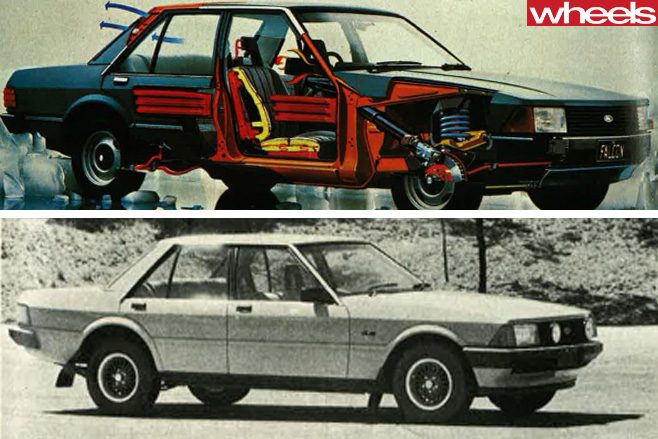
Ford Australia’s styling department developed the XD – you can trace its evolution through various clay models in our photographic study on page 93. It was never an instant car but certainly improved with every clay. Superficially, it shows a great deal of resemblance to the European Granada, especially around the nose but only the Bosch headlights are common to both. It is modern, crisp and sharper in outline than the Granada with its rounded corners and smoother edges yet the new Falcon is as European in appearance as the old XC was American. When you see the old and the new together the XD appears to be two styling generations ahead. And with a wheel in each corner there is even something of a 450SLC Mercedes-Benz about the tail.
The waistline is low, 50 mm below the XC and it is straight through and starts well below the lower edge of the windscreen, a first for a Ford anywhere. It’s a practical shape and we think Australians will like it for it retains some of the muscle and aggression that the best looking Falcons have always had but this time in a modern idiom.
After wind tunnel tests on a three-eighths model, Ford claims it has 10 percent lower drag than the XC as a result of a smaller frontal area; integral front air dam below the bumper bar; an aerofoil grille blade design which passes air through the radiator at lower speeds but directs the flow up over the bonnet at higher speeds; and the squarer styling that allows better separation of the air flow at the tail. Concealed drip gutters on the A-pillars and flush-fitting exterior mirrors reduce wind noise as well as assisting in lowering drag.
The reduced weight gives a saving of around 0.5 mpg and means better acceleration – the new high compression 3.3-litre six performs as well as the old 4.1 XC – and that the very heavy imported axle previously fitted to the 5.8-litre models could be replaced by a lighter local axle.
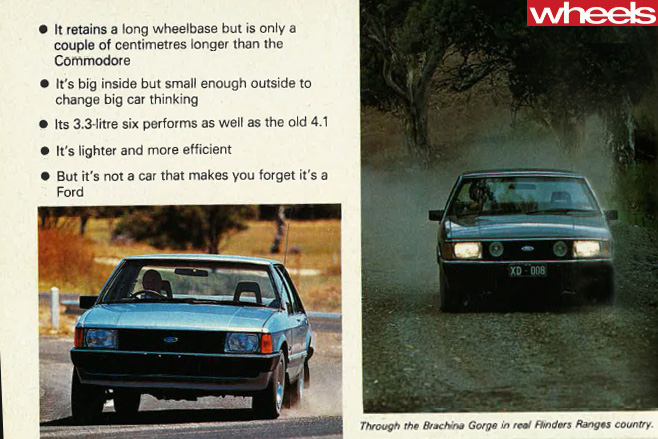
Injected moulding bumpers, which are stronger than steel and will absorb a four km/h crash without damaging the body or lights, saved 19 kg; the plastic petrol tank (hung outside the car) saved 11 kg; and the box of the old front end has been replaced by longitudinal members welded to the firewall for a saving of 11.5 kg.
Ford fans will pick the few carry-over items used on the XD – like interior door handles – but under the skin (apart from transmissions and modified engines and some suspension components) only the toe board panel that runs up the firewall and the centre floor panel follow the XC.
Unlike the Commodore, there have not been fundamental changes to the suspension. Many people will probably be surprised to learn the XD retains leaf springs al the rear. Certainly they loo strange hanging down below such a modern body but if our driving experience with the car is typical Ford’s engineers have refined them to new heights. Heights, we should add, which we believe don’t reach those of the Commodore when it comes to reaching new levels of ride/handling. But subtle refinement has indeed raised the art of the leaf spring suspension. And a lot of people use their car for towing, Ford will tell you.
Ford’s long lead preview for magazine editors – including Road and Track’s Editor in Chief Tony Hogg – was held in the Flinders Ranges: A tough backdrop in which to release any car and one which shows the company had a great deal of faith in its new product. Five cars (from the three-sedan/two wagon product range) were on hand for testing, but no wagons were included for the mid-February drive program.
In the new range the old 500 has been replaced by the GL, then comes the Fairmont and the new top-of-the-line model is the Fairmont Ghia which takes over that role from the GXL.
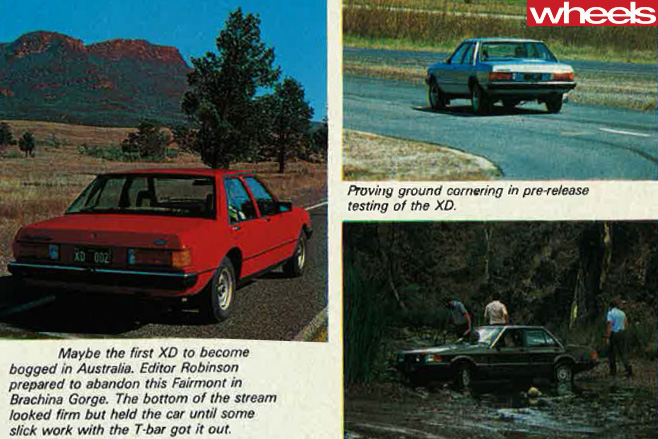
The new dashboard with its electronic instrumentation is very easy to read although we were disappointed to find the dash comes in any color you want so long as it is black. The handbrake may bring some criticism for its handle protrudes out of the lower dash and needs to be pulled out and slightly to the left of the steering. Steering wheels are soft rimmed but we found the Ghia’s two-spoke wheel rim rather too square in its forward edge. The power steering is slightly heavier – achieved by revised valving – for better feel although it doesn’t have the same is-this-really-power feel of Commodore. The manual steering still has five turns lock-to-lock but the tighter turning circle and a 10 percent faster ratio make it far more direct.
Still , the XD is not as responsive on the road as the Commodore. Tidying up the inlet ports for smoother gasflow, raising the compression ratio from the XC’s 7.8 to one to 8.8 to one and adding more spark advance has produced marked improvements in the 3.3-litre six – at the top end, anyway. With enough road, the 3.3 litre six will push the base car to 170km/h, with the only limiting factors being a long road and the realisation that the brakes are likely to lock in a panic stop. Ford claims 82kW at 4200 for the reworked six as opposed to the XC’s 75 kW at the same revs. Torque is said to be up 11Nm to 228 Nm and is reached 100 rpm lower than the XC’s 2500 rpm.
Power and torque gains in the 4.1-litre six aren’t as dramatic, with the XD,s 94 kW only 2 kW more than the XC’s 92 but arriving 100rpm sooner, at 3600rpm. Maximum torque for the 4.1 is up three Nm, at 295 Nm, and is reached 100 rpm sooner at 1800 rpm.
Both sixes and 4.9 and 5.8-litre V8s breathe through carburettors, Ford having temporarily shelved plans plans for fuel-injection for the XD. Ford engineers say injection would add $300 to the price of each car.
They also say, however, they are still assessing some of the big-name injection systems.
The most throttle-responsive of the carswe drove in the Flinders was the 5.8-litre GL manual with 2.92 diff – the closest thing you’ll find today to the old Falcon GT, pre 27A. Although it’s noisier in its S-pack form, the 5.8 manual is a rapid car.
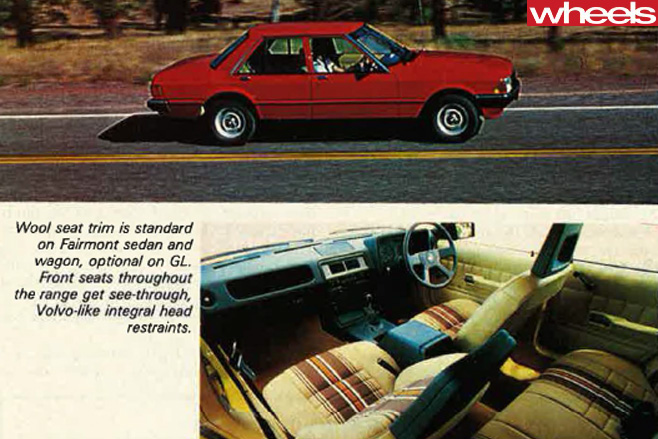
But it’s in the area of weight saving and subsequent power-to-weight improvements that Ford’s engineers are claiming major gains for the XD. Wherever possible, weight has been pared down so that the XD weighs 116 kg less than the XC, at 1367 kg. Much of the weight saving has come from the use of plastics, moulded in Ford’s incredible plastics factory – apparently the most diversified plastics factory of its type in the world – but a lot of work has gone into re-designing many of the XD’s components in high strength low alloy steel (HSLA) and by using lightening holes in some of the panels.
As Ford engineers readily admit, “With the XC, weight just crept up on us.”
As an example of the· application of HSLA steel, the engineers saved 15.4 kg in the XD’s four doors by using HSLA single-piece door intrusion beams. The front end of the car got the lightening treatment, too, and is 11.3 kg lighter than the XC. The onus has been very much on lightweight, highly-stressed designs.
Suspension members have also been significantly changed. Front anti-roll bar diameter has been increased from 18 to 20 mm in the sixes while spring rates have been softened all round. Ford says the aim is for increased roll stiffness, softened ride and dynamic tuning of the seats. Shock absorbers have been re-calibrated to suit. Steering tie-rod ends and the tie-rods themselves have been stiffened to reduce deflections in the recirculating ball steering system.
The result is a flatter-handling car than the XC and possibly even a car with less initial body roll than the Commodore. The front will plough at the limit but the car responds well when you lift off the accelerator.
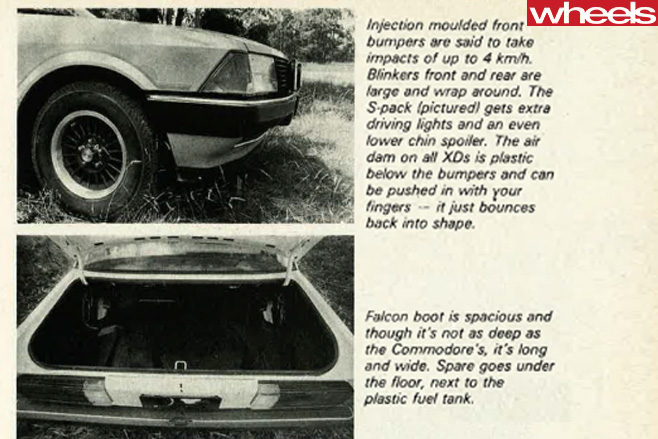
Like the Commodore, the XD is a car that surprises you when you look at the speedometer. Because so much has gone into sound-deadening in the car, you tend to drive more quickly than you feel you are. It’s the old theory – and a correct one – that to most of us speed is related to wind noise: take away much of the wind noise and you drive faster. lt’s so easy to sit on 80 km/h and think you are built-up-area legal.
lt’s also a car that encourages you to go more quickly than usual over dirt roads. Whether it’s the plastic liners inside the wheel arches or some advanced engineering Ford isn’t mentioning, there is very little gravel noise on dirt roads. Much of the Flinders drive program was over dirt roads we’d covered in the Commodore session and it seemed entirely appropriate that the XD should face the same “Waves of Destruction” section of road which surprised Editor Robinson (WHEELS, March, 1979). GMH engineers took their car over the undulating torture strip at 130 km/h with little or no trauma and while the XD was barrelled through at 120 km/h there was definite trauma. The XD may have taken the whole thing flatter but each undulation brought the car down hard on its bump stops and shook the four occupants. Not something you’d want to do every day but, as Robinson says, ”People drive through the Flinders Ranges and they meet sections of road like that.”
Ford says the XD has 332 degress visibility, helped no doubt by a 76 mm lower boot and thinner C-pillars, and the immediate impression on getting into the driver’s seat is one of airiness. The lower waistline means you see much more on either side of you, as well. The car doesn’t have the same intimidating first impression of the XC and immediately feels more manoeuvrable, simply because you can see the extremes of the car more easily.
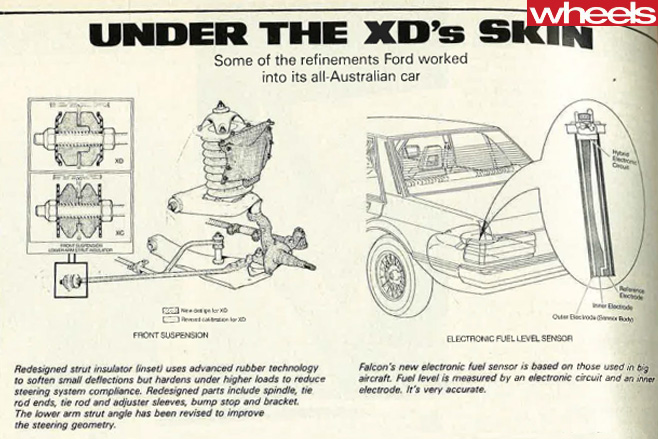
All centre console dials and switches are clearly labelled, too, which is nice.
Ventilation and heating is through two centre-console-mounted vents and single vents at either end of the dash – the any color so long as it’s black dash. The main glovebox compartment swings down and is lockable but all models get a gaping parcel shelf above – though why it doesn’t have a sliding or movable cover of some description, we don’t know. Rather than slope downwards, the shelf is horizontal, so bits and pieces will end up in the passenger’s lap when you brake.
You’ll see from our accompanying measurements that the most startling difference between XD and Commodore interior dimensions is in shoulder room – and it feels that way. Where in the Commodore the driver can reach across and touch the passenger door (with a bit of lean), it’s a Iot further across the XD.
The new-design seats help make the interior feel more airy, too. Though we felt the new seats didn’t give enough lumbar support – especially in the lower back region – and the squab was too short, Ford’s product planning people say their research has found that’s the way people like them. A lot of people, they say, complain about a seat that gives plenty of lower back support. Ford says it’s still looking at a tilt mechanism.
Seat backs are adjustable through the range (except in the bench seats, of course) but what spoils the driving position is the too-close steering wheel. The Ford men won’t confirm or deny it but it seems the protruding steering column was left that way to accommodate the three-on-the-tree which is standard on the GL and GL wagon.

Change-up points in drive were 65km/h at 4250 rpm and 100 km/h at 3800 rpm.
Next up was a 3.3-litre six Falcon GL, with the three-speed T-bar. This was the car we wound up to 170 km/h and in which we had brake lock-up when we tried a panic stop it was no surprise, really, because the brakes felt less progressive after the Fairmont and the pedal felt lighter. This car didn’t have a tachometer but was fitted with air and the new digital clock/date readout on the console: Leave it alone and it tells the time, press a button and it shows the date.
We’ve detailed the model range further on but it- might be worth explaining that the Fairmont GXL has gone, to be replaced by the Ghia though, like the Cortina, the Ghia badge doesn’t mean the car was designed by that studio. To the Ford people, the name will represent sporty luxury, or so the product planners say. Though it’s the top equipment level, the Fairmont Ghia lacks air, a cassette .system, driver’s seat height adjustment, headlight wiper/washers and the option of central locking – all of which are fitted to the Commodore SLE.
Still, the XD Falcon represents a new level in Australian-Australian cars – cars developed and built in Australia for Australian conditions. lt is a car which doesn’t have the subtlety in dynamics of the Commodore – the car which Ford insists isn’t of the same breed but a car which Australians will nevertheless use as their yardstick for a long time. If that is the case, it’s probably significant that Ford engineers believe the Commodore is too responsive for Australians.
Only the sales figures will tell.
The XD is a very good car, a car that’s a long way ahead of its predecessor in many ways. And it is a car which will be extremely popular. Like the Commodore, Ford hopes its new Falcon will draw customers away from the European imports and into a big/small Australian car. It has aimed at making the XD an easily serviced and maintained car in an effort to make its upkeep as attractive a proposition as the aesthetics of the styling; it’s a very pretty car. Whether those aesthetics can be carried through in the XD’s LTD/Fairlane derivatives – an area of the market Ford has always dominated – when they appear late April, we’ll have to wait and see.
One Ford executive explained the LTD/Fairlane market domination as “…one of the advantages of being first on the market”. lf that’s the case, the Commodore may just have that edge, too.

